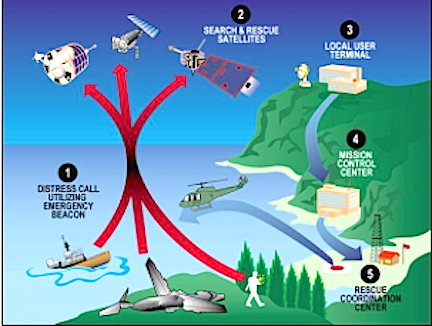
The United States will be building an operational ground station that will make a major difference for the better because...
This ground station will affect the health and safety of people by tracking Global Navigation Satellite System (GNSS) satellites* operating in medium Earth orbit (MEO) that will will receive and process 406 MHz distress beacon signals from the MEO satellites being tracked. The station will relay them to the U.S. SARSAT (Search and Rescue Satellite Aided Tracking) program’s Mission Control Center (USMCC), via U.S. government communication links, for validation and distribution to rescue authorities.

In order to accomplish this service the National Oceanic and Atmospheric Administration (NOAA) in the United States has chosen Thales to develop and build an operational ground station in the southwest part of the country, at Holloman Air Force Base in New Mexico, as part of the NOAA SARSAT system to track Global Navigation Satellite System (GNSS) satellites* operating in medium Earth orbit (MEO).
This ground station will be designated the National Oceanic and Atmospheric Administration’s (NOAA) Southwest USA Medium-Earth Orbit Local User Terminal (SUSA MEOLUT), and will be an integral part of the MEO-based ground system operated by the USMCC. The contract includes one MEOLUT Next, engineering support and optional maintenance services for 2.5 years.
This ground station will be designated the National Oceanic and Atmospheric Administration’s (NOAA) Southwest USA Medium-Earth Orbit Local User Terminal (SUSA MEOLUT), and will be an integral part of the MEO-based ground system operated by the USMCC. By deploying Thales Alenia Space’s powerful and compact MEOLUT Next phased array solution, the United States will benefit from the world’s first spaceborne search and rescue system of this type.
SUSA MEOLUT will be working in conjunction with NOAA’s two operational MEOLUTs, located at the U.S. Coast Guard’s (USCG) COMMSTA stations in Honolulu and Miami. It is expected to be an operational part of the NOAA SARSAT system on a 24/7 basis. The MEO system, which provides distress alert and location data for search and rescue (SAR) authorities in near real-time, uses spacecraft and ground facilities to detect and locate signals from the 406 MHz distress beacons.
Thales Alenia Space, a Joint Venture between Thales (67 percent) and Leonardo (33 percent) designs, operates and delivers satellite-based systems for governments and institutions, helping them position and connect anyone or anything, everywhere. Since being commissioned in 2016, MEOLUT Next has delivered unrivaled performance, detecting distress signals from more than 5,000 km away. Both France, Europe, Canada and Togo have already ordered Thales Alenia Space’s MEOLUT Next, and several more potential international customers are expected to announce their decisions shortly.
Philippe Blatt, Vice President, Navigation France at Thales Alenia Space stated that they are confident that their solution will meet and exceed NOAA SARSAT’s expectations, and provide decisive help to the UASA region. He continued that today, MEOLUT Next is the only solution in the world capable of processing second-generation beacons in real-time. Its operational efficiency was recently recognized by Space & Satellite Professionals International (SSPI) for its humanitarian contributions and the European Commission as well as governments of Togo and Canada have already selected this technology.
Further evidence that this new capability saves lives is an example given; on July 2, 2017 at 6:30 a.m., 70 kilometers off the coast of Sardinia, a 12-meter sailboat with three people aboard triggered its Cospas-Sarsat beacon when its rudder broke and its engine failed. Its VHF radio out of range, the sailors quickly realized they were in a critical situation with waves over four meters high and the wind blowing at 40 knots. MEOLUT Next was able to receive and process their distress signals in less than five minutes, providing accurate positioning to authorities. An airplane identified the boat less than two hours after the beacon was triggered and a helicopter airlifted the crew to safety, saving all three lives.
* GPS-USA, Galileo-European Commission, Glonass-Russian Federation, Beidou/Compass-China

